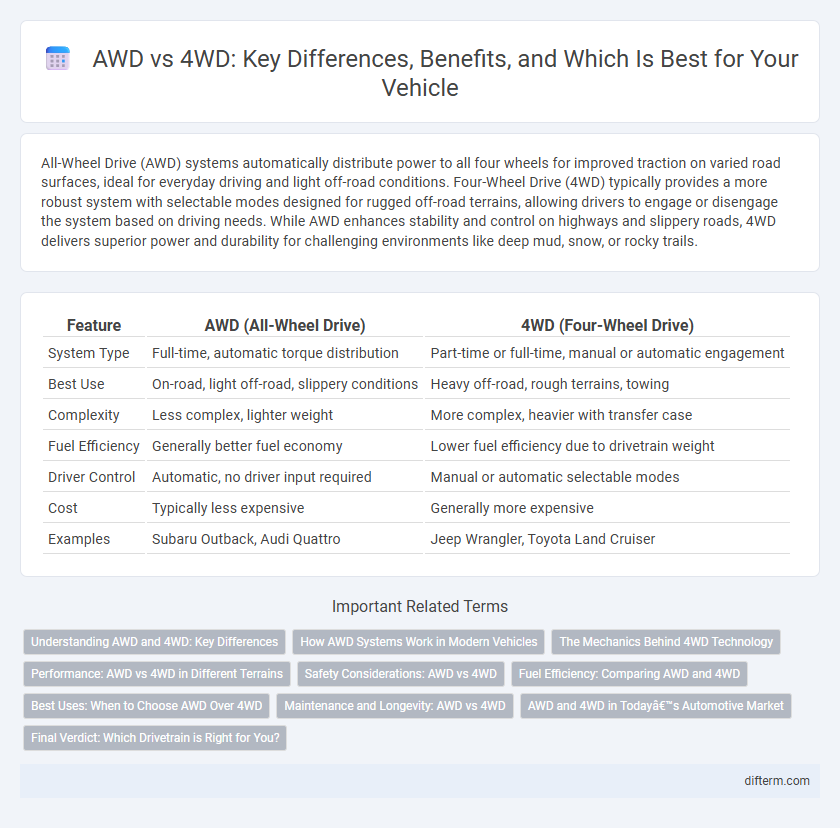All-Wheel Drive (AWD) systems automatically distribute power to all four wheels for improved traction on varied road surfaces, ideal for everyday driving and light off-road conditions. Four-Wheel Drive (4WD) typically provides a more robust system with selectable modes designed for rugged off-road terrains, allowing drivers to engage or disengage the system based on driving needs. While AWD enhances stability and control on highways and slippery roads, 4WD delivers superior power and durability for challenging environments like deep mud, snow, or rocky trails.
Table of Comparison
| Feature | AWD (All-Wheel Drive) | 4WD (Four-Wheel Drive) |
|---|---|---|
| System Type | Full-time, automatic torque distribution | Part-time or full-time, manual or automatic engagement |
| Best Use | On-road, light off-road, slippery conditions | Heavy off-road, rough terrains, towing |
| Complexity | Less complex, lighter weight | More complex, heavier with transfer case |
| Fuel Efficiency | Generally better fuel economy | Lower fuel efficiency due to drivetrain weight |
| Driver Control | Automatic, no driver input required | Manual or automatic selectable modes |
| Cost | Typically less expensive | Generally more expensive |
| Examples | Subaru Outback, Audi Quattro | Jeep Wrangler, Toyota Land Cruiser |
Understanding AWD and 4WD: Key Differences
All-Wheel Drive (AWD) systems automatically distribute torque to all four wheels, optimizing traction on varying road conditions without driver intervention, making them ideal for on-road use and light off-roading. Four-Wheel Drive (4WD) systems, typically found in trucks and SUVs, allow drivers to manually engage or disengage power delivery to the front and rear axles, enhancing off-road capability and performance in challenging terrains. AWD prioritizes continuous power distribution and safety on slippery surfaces, whereas 4WD offers greater control and durability for rigorous off-road environments.
How AWD Systems Work in Modern Vehicles
All-Wheel Drive (AWD) systems in modern vehicles automatically distribute power to both front and rear wheels for optimal traction on varying road conditions. These systems use sensors to monitor wheel speed, throttle position, and steering angle, allowing the electronic control unit (ECU) to adjust torque delivery instantly. Unlike traditional 4WD, AWD operates seamlessly without driver input, enhancing stability and handling on wet, snowy, or uneven surfaces.
The Mechanics Behind 4WD Technology
4WD technology uses a transfer case to distribute power evenly between the front and rear axles, allowing for enhanced traction on rough terrain. It typically features low-range gearing for improved torque and control in off-road conditions. This mechanical setup provides superior durability and performance in challenging environments compared to AWD systems.
Performance: AWD vs 4WD in Different Terrains
All-Wheel Drive (AWD) delivers superior traction on wet, icy, and uneven paved roads by automatically distributing power to all four wheels, optimizing performance in light off-road and slippery conditions. Four-Wheel Drive (4WD) excels in rugged off-road terrains such as mud, rocks, and deep snow by providing a manually controlled low-range gear system for enhanced torque and durability. AWD systems improve on-road handling and stability, while 4WD systems are tailored for extreme off-road capability and heavy-duty performance.
Safety Considerations: AWD vs 4WD
All-Wheel Drive (AWD) systems offer enhanced safety on wet, icy, or uneven roads by automatically distributing power to all four wheels, improving traction and stability without driver input. Four-Wheel Drive (4WD) provides superior off-road capability and traction in extreme conditions such as deep snow or rugged terrain but requires manual engagement and may compromise on-road handling. Choosing AWD enhances everyday driving safety with seamless power delivery, while 4WD is preferred for specialized off-road safety needs and severe weather scenarios.
Fuel Efficiency: Comparing AWD and 4WD
All-wheel drive (AWD) systems generally offer better fuel efficiency compared to four-wheel drive (4WD) due to their lighter weight and automatic power distribution, which reduces energy loss. AWD optimizes traction by engaging all wheels only when necessary, minimizing fuel consumption during regular driving conditions. In contrast, traditional 4WD systems are heavier and often operate in full-time mode, resulting in increased fuel usage, especially on paved roads.
Best Uses: When to Choose AWD Over 4WD
AWD systems are ideal for everyday driving and light off-road conditions, offering continuous power to all wheels for enhanced traction on wet or slippery roads. Choose AWD for improved handling and safety during inclement weather without the complexity of manual engagement found in 4WD systems. AWD is best suited for urban environments, light snow, and rain, where seamless power distribution boosts stability and control.
Maintenance and Longevity: AWD vs 4WD
All-Wheel Drive (AWD) systems typically require less maintenance than Four-Wheel Drive (4WD) due to their fully automatic operation and sealed components, reducing wear from manual engagement errors. 4WD vehicles often face higher maintenance costs because their transfer cases and locking differentials need regular inspection and servicing to ensure durability under off-road and heavy-duty conditions. Proper upkeep of either system can extend longevity, but AWD is generally more suited for daily driving with lower long-term maintenance demands.
AWD and 4WD in Today’s Automotive Market
All-Wheel Drive (AWD) systems dominate today's automotive market by providing seamless traction on varied road conditions through automatic power distribution to all wheels, enhancing safety and performance in everyday driving. Four-Wheel Drive (4WD) remains preferred for off-road and heavy-duty applications due to its robust, manually controlled system capable of handling extreme terrain and towing demands. Manufacturers increasingly integrate AWD in SUVs and crossovers, catering to urban drivers seeking improved stability without compromising fuel efficiency.
Final Verdict: Which Drivetrain is Right for You?
AWD offers superior traction and handling on various paved and slippery surfaces, making it ideal for everyday driving and light off-road conditions. 4WD provides robust power delivery and control in challenging off-road environments, suitable for rugged terrains and heavy-duty use. Choosing between AWD and 4WD depends on your driving needs: prioritize AWD for improved safety and convenience in mixed conditions, or 4WD for serious off-road performance and maximum control.
AWD vs 4WD Infographic

 difterm.com
difterm.com